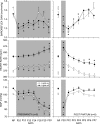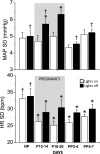Pregnancy impairs baroreflex control of heart rate in rats: role of insulin sensitivity
- PMID: 19939977
- PMCID: PMC2828176
- DOI: 10.1152/ajpregu.00441.2009
Pregnancy impairs baroreflex control of heart rate in rats: role of insulin sensitivity
Abstract
Recent studies in rabbits suggest that insulin resistance and reduced brain insulin contribute to impaired baroreflex control of heart rate (HR) during pregnancy; however, the mechanisms are unknown. The rat model is ideal to investigate these mechanisms because much is known about rat brain baroreflex neurocircuitry and insulin receptor locations. However, it is unclear in rats whether pregnancy impairs the HR baroreflex or whether insulin resistance is involved. Therefore, this study tested the hypothesis that in rats pregnancy decreases HR baroreflex sensitivity (BRS) and that this decrease is related to concurrent decreases in insulin sensitivity (IS). BRS was quantified before, during, and after pregnancy using complementary methods: 1) spontaneous BRS (sBRS) derived from sequence method analysis of telemetric, continuous arterial pressure recordings; and 2) maximal BRS of complete sigmoidal baroreflex relationships. IS was measured (hyperinsulinemic euglycemic clamp) to determine whether BRS and IS change in parallel. sBRS was reduced at midgestation [pregnancy day 10 (P10)], returned to nonpregnant (NP) levels on P18, and fell again at late gestation (P20) (sBRS in ms/mmHg: NP, 1.66 + or - 0.04; P10, 1.17 + or - 0.11; P18, 1.55 + or - 0.12; P20, 1.31 + or - 0.05; n = 5; P < 0.05). Similar triphasic patterns were observed for both maximal BRS [in beats x min(-1) x mmHg(-1): NP, 4.45 + or - 0.52 (n = 10); P11-12, 2.76 + or - 0.11 (n = 7); P17-18, 3.79 + or - 0.14 (n = 5); P19-20, 2.32 + or - 0.40 (n = 8); P < 0.0001] and previous and current measurements of IS (in mg glucose x kg(-1) x min(-1): NP, 32 + or - 2; P19-20, 15 + or - 1; P < 0.0005). Furthermore, during pregnancy, the standard deviation (SD) of MAP increased, and the SD of HR decreased, indirectly suggesting baroreflex impairment. sBRS increased transiently during parturition, and sBRS, maximal BRS, and IS normalized 3-4 days postpartum. In conclusion, pregnancy decreases HR BRS in rats. The parallel temporal changes in BRS and IS suggest a mechanistic link.
Figures




Similar articles
-
Baroreflex function in females: changes with the reproductive cycle and pregnancy.Gend Med. 2012 Apr;9(2):61-7. doi: 10.1016/j.genm.2012.02.004. Gend Med. 2012. PMID: 22483197 Free PMC article. Review.
-
Baroreflex sensitivity varies during the rat estrous cycle: role of gonadal steroids.Am J Physiol Regul Integr Comp Physiol. 2009 May;296(5):R1419-26. doi: 10.1152/ajpregu.91030.2008. Epub 2009 Mar 4. Am J Physiol Regul Integr Comp Physiol. 2009. PMID: 19261912 Free PMC article.
-
Augmentation of nitric oxide is crucial for the time-dependent effects of rosiglitazone on blood pressure and baroreflex function in rats.J Hypertens. 2008 Jan;26(1):83-92. doi: 10.1097/HJH.0b013e3282f11934. J Hypertens. 2008. PMID: 18090544
-
Hyperinsulinemia instead of insulin resistance induces baroreflex dysfunction in chronic insulin-infused rats.Am J Hypertens. 2007 Apr;20(4):451-8. doi: 10.1016/j.amjhyper.2006.11.004. Am J Hypertens. 2007. PMID: 17386355
-
Assessment of baroreflex sensitivity from spontaneous oscillations of blood pressure and heart rate: proven clinical value?Physiol Meas. 2015 Apr;36(4):741-53. doi: 10.1088/0967-3334/36/4/741. Epub 2015 Mar 23. Physiol Meas. 2015. PMID: 25798657 Review.
Cited by
-
Protective effect of the daming capsule on impaired baroreflexes in STZ-induced diabetic rats with hyperlipoidemia.BMC Complement Altern Med. 2010 Dec 22;10:80. doi: 10.1186/1472-6882-10-80. BMC Complement Altern Med. 2010. PMID: 21176164 Free PMC article.
-
Impaired baroreflex gain during pregnancy in conscious rats: role of brain insulin.Hypertension. 2011 Feb;57(2):283-8. doi: 10.1161/HYPERTENSIONAHA.110.162354. Epub 2010 Dec 13. Hypertension. 2011. PMID: 21149828 Free PMC article.
-
Insulin acts in the arcuate nucleus to increase lumbar sympathetic nerve activity and baroreflex function in rats.J Physiol. 2011 Apr 1;589(Pt 7):1643-62. doi: 10.1113/jphysiol.2011.205575. Epub 2011 Feb 7. J Physiol. 2011. PMID: 21300750 Free PMC article.
-
Pregnancy and the endocrine regulation of the baroreceptor reflex.Am J Physiol Regul Integr Comp Physiol. 2010 Aug;299(2):R439-51. doi: 10.1152/ajpregu.00059.2010. Epub 2010 May 26. Am J Physiol Regul Integr Comp Physiol. 2010. PMID: 20504907 Free PMC article. Review.
-
Baroreflex function in females: changes with the reproductive cycle and pregnancy.Gend Med. 2012 Apr;9(2):61-7. doi: 10.1016/j.genm.2012.02.004. Gend Med. 2012. PMID: 22483197 Free PMC article. Review.
References
-
- Avery ND, Wolfe LA, Amara CE, Davies GA, McGrath MJ. Effects of human pregnancy on cardiac autonomic function above and below the ventilatory threshold. J Appl Physiol 90: 321–328, 2001 - PubMed
-
- Azar AS, Brooks VL. Increases in brain insulin normalize baroreflex gain in conscious pregnant rats (Abstract). FASEB J 22: 1228.3 2008
-
- Bertinieri G, Di Rienzo M, Cavallazzi A, Ferrari AU, Pedotti A, Mancia G. A new approach to analysis of the arterial baroreflex. J Hypertens Suppl 3: S79–S81, 1985 - PubMed
-
- Blake MJ, Martin A, Manktelow BN, Armstrong C, Halligan AW, Panerai RB, Potter JF. Changes in baroreceptor sensitivity for heart rate during normotensive pregnancy and the puerperium. Clin Sci 98: 259–268, 2000 - PubMed
-
- Brooks VL, Clow KA, Welch LS, Giraud GD. Does nitric oxide contribute to the basal vasodilation of pregnancy in conscious rabbits? Am J Physiol Regul Integr Comp Physiol 281: R1624–R1632, 2001 - PubMed
Publication types
MeSH terms
Substances
Grants and funding
LinkOut - more resources
Full Text Sources
Medical
Miscellaneous

